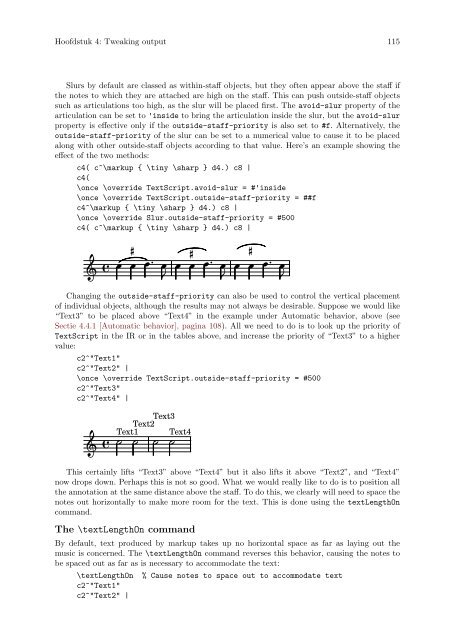LilyPond Beginnershandleiding
LilyPond Beginnershandleiding
LilyPond Beginnershandleiding
You also want an ePaper? Increase the reach of your titles
YUMPU automatically turns print PDFs into web optimized ePapers that Google loves.
Hoofdstuk 4: Tweaking output 115<br />
Slurs by default are classed as within-staff objects, but they often appear above the staff if<br />
the notes to which they are attached are high on the staff. This can push outside-staff objects<br />
such as articulations too high, as the slur will be placed first. The avoid-slur property of the<br />
articulation can be set to 'inside to bring the articulation inside the slur, but the avoid-slur<br />
property is effective only if the outside-staff-priority is also set to #f. Alternatively, the<br />
outside-staff-priority of the slur can be set to a numerical value to cause it to be placed<br />
along with other outside-staff objects according to that value. Here’s an example showing the<br />
effect of the two methods:<br />
c4( c^\markup { \tiny \sharp } d4.) c8 |<br />
c4(<br />
\once \override TextScript.avoid-slur = #'inside<br />
\once \override TextScript.outside-staff-priority = ##f<br />
c4^\markup { \tiny \sharp } d4.) c8 |<br />
\once \override Slur.outside-staff-priority = #500<br />
c4( c^\markup { \tiny \sharp } d4.) c8 |<br />
<br />
<br />
<br />
<br />
<br />
<br />
<br />
<br />
<br />
<br />
<br />
<br />
<br />
<br />
<br />
<br />
Changing the outside-staff-priority can also be used to control the vertical placement<br />
of individual objects, although the results may not always be desirable. Suppose we would like<br />
“Text3” to be placed above “Text4” in the example under Automatic behavior, above (see<br />
Sectie 4.4.1 [Automatic behavior], pagina 108). All we need to do is to look up the priority of<br />
TextScript in the IR or in the tables above, and increase the priority of “Text3” to a higher<br />
value:<br />
c2^"Text1"<br />
c2^"Text2" |<br />
\once \override TextScript.outside-staff-priority = #500<br />
c2^"Text3"<br />
c2^"Text4" |<br />
<br />
Text3<br />
Text2<br />
Text1 Text4<br />
<br />
This certainly lifts “Text3” above “Text4” but it also lifts it above “Text2”, and “Text4”<br />
now drops down. Perhaps this is not so good. What we would really like to do is to position all<br />
the annotation at the same distance above the staff. To do this, we clearly will need to space the<br />
notes out horizontally to make more room for the text. This is done using the textLengthOn<br />
command.<br />
The \textLengthOn command<br />
By default, text produced by markup takes up no horizontal space as far as laying out the<br />
music is concerned. The \textLengthOn command reverses this behavior, causing the notes to<br />
be spaced out as far as is necessary to accommodate the text:<br />
\textLengthOn % Cause notes to space out to accommodate text<br />
c2^"Text1"<br />
c2^"Text2" |



